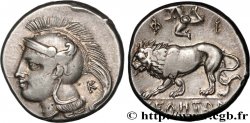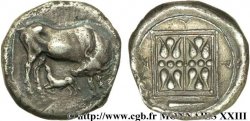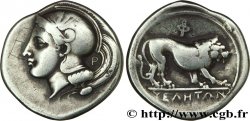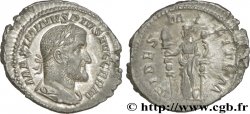v29_0003 - LUCANIA - VELIA Nomos, statère ou didrachme
MONNAIES 29 (2007)
Starting price : 325.00 €
Estimate : 550.00 €
Realised price : 432.00 €
Number of bids : 2
Maximum bid : 432.00 €
Starting price : 325.00 €
Estimate : 550.00 €
Realised price : 432.00 €
Number of bids : 2
Maximum bid : 432.00 €
Type : Nomos, statère ou didrachme
Date: c. 365-350/340 AC
Mint name / Town : Vélia
Metal : silver
Diameter : 23 mm
Orientation dies : 12 h.
Weight : 7,25 g.
Rarity : R1
Emission: 52e
Coments on the condition:
Exemplaire à l’usure régulière. A été nettoyé anciennement. Beau portrait. Flan très large, bien centré des deux côtés. Frappe un peu molle au revers. Une fine patine grise recouvre l’exemplaire
Catalogue references :
Obverse
Obverse description : Tête d'Athéna à gauche, coiffée du casque attique à cimier avec triple aigrette, orné d’un griffon.
Obverse legend : RQ
Reverse
Reverse description : Lion passant à droite .
Reverse legend : UELHTWN/ F
Commentary
Mêmes coins que l’exemplaire du British Museum (BMC. 56) Un graffiti devant le visage (epsilon, E). R. Williams a étudié la dégradation du coin de droit (A/152) et du coin de revers (R/ 203) et a déterminé six phases différentes. Très tôt, le monnayage de Vélia a été décrit comme ayant inspiré la drachme lourde de Marseille (LT. 785-791). Certains l’ont même décrit comme un monnayage symmachique : un lion de Vélia étant l’équivalent de deux lions de Marseille. Aujourd’hui, cette théorie est remise en cause, par G. Depeyrot, non sans arguments, mais avec une certaine acrimonie. Le lion de Vélia a pu servir de modèle à celui de Marseille, mais à quelle date ? La frappe à Vélia commence dans la seconde moitié du Ve siècle avant J.-C. pour se poursuivre jusqu’en 281 avant J.-C. À quel moment les Massaliotes auraient-ils emprunté le lion de Vélia ?.
Same dies as the British Museum copy (BMC. 56) Graffiti in front of the face (epsilon, E). R. Williams studied the degradation of the obverse die (A/152) and the reverse die (R/ 203) and identified six different phases. Very early on, the coinage of Velia was described as having inspired the heavy drachma of Marseille (LT. 785-791). Some have even described it as a symmachy coinage: one lion of Velia being the equivalent of two lions of Marseille. Today, this theory is challenged, not without argument, but with some acrimony, by G. Depeyrot. The lion of Velia could have served as a model for that of Marseille, but at what date? Minting at Velia began in the second half of the 5th century BC and continued until 281 BC. When did the Massaliotes borrow the lion of Velia?
Same dies as the British Museum copy (BMC. 56) Graffiti in front of the face (epsilon, E). R. Williams studied the degradation of the obverse die (A/152) and the reverse die (R/ 203) and identified six different phases. Very early on, the coinage of Velia was described as having inspired the heavy drachma of Marseille (LT. 785-791). Some have even described it as a symmachy coinage: one lion of Velia being the equivalent of two lions of Marseille. Today, this theory is challenged, not without argument, but with some acrimony, by G. Depeyrot. The lion of Velia could have served as a model for that of Marseille, but at what date? Minting at Velia began in the second half of the 5th century BC and continued until 281 BC. When did the Massaliotes borrow the lion of Velia?








 Report a mistake
Report a mistake Print the page
Print the page Share my selection
Share my selection Ask a question
Ask a question Consign / sell
Consign / sell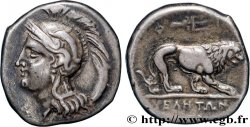
 Full data
Full data


